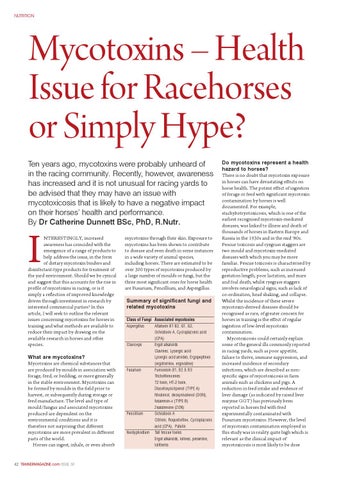MYCOTOXINS ISSUE 30 NEW:Jerkins feature.qxd
20/5/10
18:06
Page 1
NUTRITION
Mycotoxins – Health Issue for Racehorses or Simply Hype? Ten years ago, mycotoxins were probably unheard of in the racing community. Recently, however, awareness has increased and it is not unusual for racing yards to be advised that they may have an issue with mycotoxicosis that is likely to have a negative impact on their horses’ health and performance. By Dr Catherine Dunnett BSc, PhD, R.Nutr.
I
NTERESTINGLY, increased awareness has coincided with the emergence of a range of products to help address the issue, in the form of dietary mycotoxin binders and disinfectant-type products for treatment of the yard environment. Should we be cynical and suggest that this accounts for the rise in profile of mycotoxins in racing, or is it simply a reflection of improved knowledge driven through investment in research by interested commercial parties? In this article, I will seek to outline the relevant issues concerning mycotoxins for horses in training and what methods are available to reduce their impact by drawing on the available research in horses and other species. What are mycotoxins? Mycotoxins are chemical substances that are produced by moulds in association with forage, feed, or bedding, or more generally in the stable environment. Mycotoxins can be formed by moulds in the field prior to harvest, or subsequently during storage or feed manufacture. The level and type of mould/fungus and associated mycotoxins produced are dependent on the environmental conditions and it is therefore not surprising that different mycotoxins are more prevalent in different parts of the world. Horses can ingest, inhale, or even absorb
42 TRAINERMAGAZINE.com ISSUE 30
mycotoxins through their skin. Exposure to mycotoxins has been shown to contribute to disease and even death in some instances in a wide variety of animal species, including horses. There are estimated to be over 300 types of mycotoxins produced by a large number of moulds or fungi, but the three most significant ones for horse health are Fusarium, Pencillium, and Aspergillus. Summary of significant fungi and related mycotoxins Class of Fungi Associated mycotoxins Aspergillus Aflatoxin B1 B2, G1, G2, Ochratoxin A, Cyclopiazonic acid (CPA) Claviceps Ergot alkaloids Clavines, Lysergic acid Lysergic acid amides, Ergopeptines (ergotomine, ergovaline) Fusarium Fumonisin B1, B2 & B3 Trichothencenes T2 toxin, HT-2 toxin, Diacetoxyscirpenol (TYPE A) Nivalenol, deoxynivalenol (DON), fusarenon-x (TYPE B) Zearalenone (ZON) Pencillium Ochratoxin A Citrinin, Roquefortine, Cyclopiazonic acid (CPA), Patulin Neotyphodium Tall fescue toxins Ergot alkaloids, lolines, peramine, lolitrems
Do mycotoxins represent a health hazard to horses? There is no doubt that mycotoxin exposure in horses can have devastating effects on horse health. The potent effect of ingestion of forage or feed with significant mycotoxin contamination by horses is well documented. For example, stachybotryotoxicosis, which is one of the earliest recognised mycotoxin-mediated diseases, was linked to illness and death of thousands of horses in Eastern Europe and Russia in the 1930s and in the mid ‘80s. Fescue toxicosis and ryegrass staggers are two mould and mycotoxin-mediated diseases with which you may be more familiar. Fescue toxicosis is characterised by reproductive problems, such as increased gestation length, poor lactation, and mare and foal death, whilst ryegrass staggers involves neurological signs, such as lack of co-ordination, head shaking, and collapse. Whilst the incidence of these severe mycotoxin-derived diseases should be recognised as rare, of greater concern for horses in training is the effect of regular ingestion of low-level mycotoxin contamination. Mycotoxicosis could certainly explain some of the general ills commonly reported in racing yards, such as poor appetite, failure to thrive, immune suppression, and increased incidence of secondary infections, which are described as nonspecific signs of mycotoxicosis in farm animals such as chickens and pigs. A reduction in feed intake and evidence of liver damage (as indicated by raised liver enzyme GGT) has previously been reported in horses fed with feed experimentally contaminated with Fusarium mycotoxins. However, the level of mycotoxin contamination employed in this study was in reality quite high which is relevant as the clinical impact of mycotoxicosis is most likely to be dose
